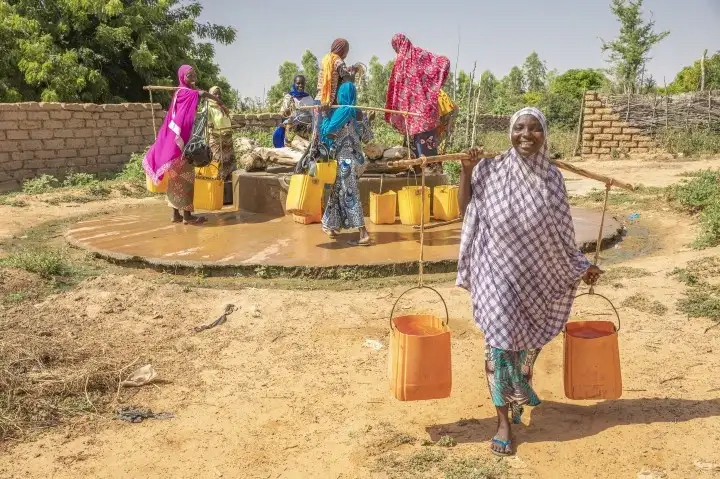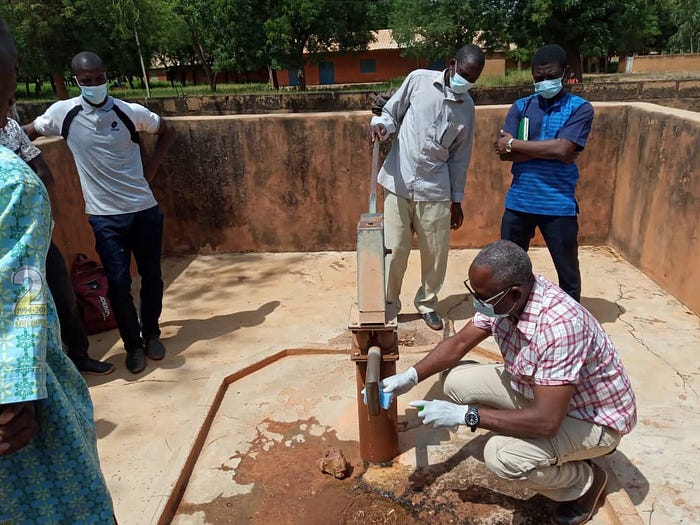
Photo credit: Ezra Millstein/Mercy Corps
Burkina Faso and Niger have some of the lowest rates of access to safe water and sanitation in the world. Water scarcity and water resource mismanagement in both countries undermine farming and livestock livelihoods, and sometimes create conflict. Growing risks associated with droughts and floods, combined with populations that increasingly face internal displacement due to violent conflict, undermine the prospects for economic growth and poverty alleviation. People in these Sahel nations who face these shocks and stressors often suffer through one humanitarian crisis after another, and the impact of the COVID-19 pandemic has intensified these challenges.

Photo credit: Sean Sheridan/Mercy Corps
USAID is working to break this cycle through an approach that combines emergency humanitarian aid with long-term development assistance. It is doing so through the second iteration of its Resilience in the Sahel Enhanced (RISE II) program, a broad five-year, more than $700 million program that is being implemented in Burkina Faso and Niger. RISE II addresses governance; water, sanitation, and hygiene (WASH); health; family planning; nutrition; food security; economic well-being; and empowering women and youth.
Water insecurity and pervasive shocks and stresses are two of Burkina Faso’s and Niger’s most critical challenges. RISE II includes the TerresEauVie (TEV) activity, whose central focus is water security. TEV, started in 2019, also focuses on food security, land access, and natural resources management. The $39 million activity has helped vulnerable populations effectively manage shocks and stresses such as droughts and floods and pursue sustainable pathways out of poverty.
TEV has three objectives: improved water security; productive land use; and improved management of shocks, risks, and stresses. “I think it’s actually the first [activity] of its kind in the Sahel,” says Maggie Janes-Lucas, director of the Sahel Collaboration and Communication project, which works in partnership with TEV. “It is quite unique and quite important.”

Photo credit: TerresEauVie
Building the Capacity of Local Government to Address Water Insecurity
TEV works mainly at the commune level — the rough equivalent of a county government in the United States. It also collaborates with other RISE II related projects as well as government agencies at the village, regional, and national levels. TEV’s goal is to build local capacity for long-term management of water and land resources along with shock preparedness and response. TEV focuses on 25 (out of 250) of Niger’s communes, or 4,100 villages, and 15 (out of 350) of Burkina Faso’s communes, or 700 villages.
As one of its first tasks, TEV assessed the capacity of commune officials to manage people’s concerns and expectations about water and land related issues. “With [commune officials], we are developing plans for their improvement, where they see their issues, where they see their strengths, and where they want to take this,” explains Harvey Schartup, TEV’s director. “Together, we develop a capacity-building plan.” He says that over the coming years, TEV will train commune officials and their staff to increase their management, collaboration, and planning skills. These enhanced skills are one puzzle piece in the overall systemic approach to help officials better manage and improve operations. They also allow them to better anticipate, prepare, and respond to the shocks associated with more frequent extreme climate events and insecurity situations.

Photo credit: Mercy Corps
Making Data for Planning Available and Usable
TEV is also working to improve the data available to communes so that they can make more informed decisions about water resources and WASH investments. In both Niger and Burkina Faso, communes are responsible for managing land, natural resources, and infrastructure development. These communes need to know the condition and location of all their health centers, water wells, roads, and cattle corridors. “All of this information that is dispersed, we are trying to bring it all together so the users would be able to have a systemic and long-range view of a particular geographic area,” explains Schartup.

Photo credit: TerresEauVie
Communes are particularly interested in using these data to develop local land use and natural resource and risk management plans that address water resources, whether for agricultural, industrial, or household use. Currently, local water agencies do not have this sort of management tool. “This is new for them, and they are very interested in using and adding to this information we are providing them,” says Patrice Beaujault, TEV deputy director.
For example, in southwestern Niger, officials in Filingué looked for ways to solve frequent conflicts over water sources. TEV, in collaboration with other RISE II implementers, helped communal authorities and stakeholders map out the various resources and competing interests in the area. Together they developed a plan and a series of administrative ordinances, called a Local Convention, that established fair water and land use. The commune adopted its Local Convention in January 2020.

Photo credit: TerresEauVie
Coping with the Pandemic
Burkina Faso’s capital city Ouagadougou reported the country’s first case of COVID-19 on March 9, 2020. In the days that followed, leaders from around the country struggled to respond. “I quickly issued a municipal order to close the markets and ban demonstrations that could potentially mobilize large numbers of people,” says Amadou Tamboura, mayor of Seytenga in the country’s north. “I also asked people to respect the measures taken by the government. But what more can we do with our resources? It was at this point that TerresEauVie proposed that we draw up a communal response and prevention plan to respond to COVID-19.”
I also noticed that people now wash their hands when they arrive at the Health Center.
As part of the resulting plan, TEV supported the commune in conducting an information campaign via local radio in partnership with the Ministry of Health. One program featured a local nurse, Ahmadou Maiga, answering questions from listeners. “Some people thanked me by phone and in person at the Health Center for the clarity of the explanations,” Maiga said. “I also noticed that people now wash their hands when they arrive at the Health Center.”

Photo credit: TerresEauVie
TEV is doing similar work in Niger. In the Maradi region’s Chadakori commune, TEV worked with local officials to develop a simple framework for their COVID-19 contingency plan. Community members, including youth and women’s groups, worked together and led the data collection and analysis process to draw up the plan. TEV brought together the Crisis and Disaster Prevention and Management Sub-Regional Committee, the mayor, and communal technical services to review the first version of the plan together. This allowed them to go into greater detail around the plan’s objectives, vulnerability factors, and expected results, and to develop a more concrete working relationship between local and regional authorities.
“We have a contingency plan that meets our standards,” says Zeinabou Ibrahim, the commune’s secretary general. “We have now mastered the methodology for developing good contingency plans.” TEV has now begun supporting communes to transform their COVID-19 plans into communal multi-risk plans, encompassing a long-term perspective for addressing broader shock preparedness and response.

Photo credit: TerresEauVie
Goal Is Self-Reliance
In all of TEV’s work, the hope is to have a wider impact on water security in more than just the target communes in Burkina Faso and Niger. “Our vision goes beyond our targeted communities and those three component areas,” says Schartup. “We work with the communes and their support structures from day one, facilitating, mentoring, and assisting their efforts with the goal of long-term sustainable self-reliance. The aim is to develop successful, locally adapted models that the government will be able to expand beyond the 25 communes in Niger and 15 in Burkina Faso.”
“The idea at the end of the day is for self-reliance at the communal level,” agrees Beaujault.

